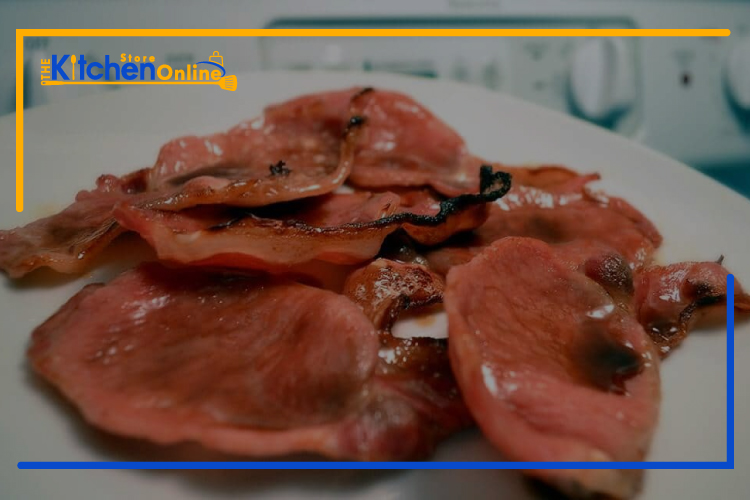A typical American consumes 18 pounds of bacon per year, making it one of the most popular meat cuts in the country.
Bacon is made from the belly or back of a pig and is commonly eaten as part of breakfast or in sandwiches, burgers, salads, soups, and pizzas.
Bacon is produced all over the world with different methods of preparation, curing, and cutting.
A few popular types of bacon are American type, Canadian type, British type, and of course Irish type.
What is Irish bacon? It is made from the back or shoulders of a pig and is a popular breakfast item in Ireland. The bacon that can be found in America is made from the belly of a pig.
Discover what Irish bacon is, how it is made, and what it can be substituted with!
How Is Irish Bacon Made?
It is part of a complicated Irish breakfast that includes eggs, blood pudding, white pudding, and bacon. It is also called back bacon because of the part of the pig it comes from.
Both are cured, made from the backs of pigs, and are roughly the same thickness. As opposed to thin strips of bacon, Irish bacon is often round and contains more fat.
Its distinctive flavor comes from the layer of fat surrounding it. This condiment can be used in salads, omelets, frittatas, sandwiches, and pasta.
Bacon from Canada is a little leaner, meatier, and a little bit less fatty than American bacon. Canadian bacon is cooked until done but is not crispy.
In traditional Irish cooking, bacon is cooked and cured, then removed from the heat before becoming crispy. In addition to increasing the meat’s shelf life, curing it adds a unique flavor and makes it more flavorful.
There are some Irish bacon that are not cured. The curing process is sometimes done using basic brine, which takes more time than the curing process for other kinds of bacon.
Smoking Irish bacon is also an option, but that depends on your taste.
How To Cure Irish Bacon
The following steps will show you how to cure five pounds of Irish bacon:
- You will need a certain amount of cure mixture. You will need the same amount of brine mixture as you would for five pounds of Irish bacon.
- Cure mixtures may be prepared either from scratch or from store-bought mixes. There are numerous ingredients commonly found in the curing mix, including garlic, maple syrup, bay leaves, thyme, nutmeg, and juniper berries. Other alternative sugars and honey are available.
- Rub the curing mixture on the meat evenly to evenly coat it. Seal the bag or container tightly to prevent moisture from entering.
- Cure the bacon in a refrigerator at a temperature between 34 and 40 degrees Fahrenheit for 7 days.
- Curing the meat for one week should be adequate if its maximum thickness is 1 inch. A 2-inch thickness will require 2 weeks of curing.
- Rub the meat again halfway through to distribute the spice mixture and any liquid that has collected in the container.
- Rinse the cured meat with water after it has been in the fridge for 1-2 weeks.
- A temperature of 140-200°F should be reached in the oven or smoker. If you are using a smoker, make sure the damper remains open since you are only attempting to dry-cure it.
- Cook the meat for 90 minutes on a baking tray or in a smoker.
- Make sure the thickest part of the meat is at the correct temperature with a meat thermometer. Smoked meat must not be removed until the internal temperature reaches 150°F.
- Reddish-brown color means that the meat is ready.
- Cool the meat after it has been removed from the heat.
- Serve it cold or frozen, wrapped in plastic or aluminum.
How To Cook Irish Bacon
Cooking bacon after it has been cured can be done in a variety of ways. You can use a skillet, bake it in the oven, or microwave it.
You need to slice the cured bacon and allow it to come to room temperature after you remove it from the fridge. This is a classic method that uses a skillet.
Using either butter or American bacon fat, brown the bacon lightly in the pan over medium heat.
Alternatively, you can microwave or bake the bacon. If you have large batches to prepare and some extra time on your hands, you might want to consider an oven.
Upon completion, you can serve the tasty Irish bacon as part of your favorite breakfast dishes, such as sunny side-up eggs and omelets, or add them to your favorite burgers or sandwiches.
Boiling bacon is also produced in Ireland and it is called Irish boiling bacon. This bacon is traditionally cured, netted, and smoked in a traditional Irish manner.
Many people don’t know How To Reheat Bacon? visit this to know the best way.
Best Substitutes For Irish Bacon
What is a good substitute for Irish bacon when you cannot find it? Bacon and meats of all kinds are readily available, so finding good substitutes isn’t that hard.
Slices of ham, Canadian bacon, and pancetta can be used in place of Irish bacon. In addition to replacing breakfast Irish bacon, the first two are great options for toppings.
The loin of the pig is used to make Canadian bacon the same way it is for Irish bacon and it is sometimes referred to as back bacon.
Lean and juicy, it is served at a soft, juicy stage rather than crisped up as Irish bacon would be.
Salting and smoking are used to cure it, as with conventional bacon. Despite its sweetness, Irish bacon is a little sweeter than American bacon.
US Hawaiian pizza often includes Canadian bacon as a topping. Bacon is also eaten for breakfast.
The cured smokey bacon flavor can also easily be achieved without using actual bacon by using smoked ham.
You can use bacon in place of ham since both products are cured and packaged differently, as well as being from different parts of a pig.
Alternatively, when there is no Irish bacon available, you may substitute pancetta.
A porc belly is salted and seasoned and used to make pancetta in Italy.
Pancetta comes from salt-cured and dried bacon, whereas Irish bacon comes from smoked pork.
Second, pancetta can be served uncooked and cooked. Bacon, however, is still raw and must be cooked.
Despite that, it is a tasty alternative to Irish bacon and a good topping for salads, pasta, rice, or soup.
Irish Bacon Recipe
This is a traditional Hungarian dish made with bacon and cabbage. It is a traditional Irish dish that can be made for St. Patrick’s Day:
Ingredients:
- Bacon boiling in Irish whiskey 4 pounds
- Chop, quarter, and core 1 cabbage
- Four tablespoons of unsalted butter
- Pepper that has recently been ground
- Sauce made from parsley
- For serving, boil potatoes
Directions
- Pour enough water over the bacon so that it is completely covered.
- Put it on medium-high heat until it boils.
- Water will form a white froth if the bacon is too salty. When this occurs, discard the water and restart the process.
- Rinse until the water surfaces are free of froth.
- Cook the bacon for 1 hour under the cover of a pot until almost done.
- While waiting, shred the cabbage thinly and wash it under cold water if necessary.
- With the bacon still in the pot, add the cabbage and simmer for 20 more minutes.
- Serve the bacon and cabbage hot, with the bacon removed from the pot and the cabbage strained.
- Season butter with pepper and add butter.
- Garnish with parsley sauce and potatoes, and serve alongside bacon and cabbage.
Related Questions
In our detailed guide above, we covered all the important points related to Irish bacon. Here are a few additional questions related to the shelf-life of raw and cooked bacon, and how to tell if it is bad!
How long does bacon last?
Bacon, whether it is prepared at home or purchased in the grocery store, comes with a “sell-by” date written on the package.
In general, this date indicates how long bacon remains good. Bacon not only needs more time for cooking, but also depends on how it is stored, its condition, and whether it is opened.
When kept frozen, bacon will last up to 8 months if kept in the fridge for two weeks.
Opened but uncooked bacon will only keep in the refrigerator for about 1 week and in the freezer for up to 6 months.
The shelf-life of cooked bacon is relatively short and can last only for up to 1 month in the freezer or about 4-5 days in the refrigerator.
How long does home-cured bacon last?
Depending on the curing mix and whether it was vacuum-sealed, homemade bacon will last for 1-2 weeks in the refrigerator.
For up to 6 months or longer, you can freeze cured bacon if you are not going to use it soon. You can seal, slice, or leave it in whole pieces.
Once it has defrosted, place it in ice water or transfer it to the refrigerator to defrost.
How long can cooked bacon sit out of the refrigerator?
Due to its cured nature, some people believe that bacon can be left out overnight without going bad (as it belongs to the cured meat category).
There is even a belief that it can last for several days if it isn’t contaminated. Bacon without nitrites is not subject to this rule.
You should refrigerate or consume bacon as soon as possible after it has been sitting outside, regardless of whether it is cured or not.
If you notice that your bacon is now smelling funny, has a slimy layer on top, or if you see mold, it is past its best and you should toss it right away.
How do you store bacon?
Bacon cannot only benefit from proper storage but also maintain its quality. In general, you should always store bacon directly after use in the fridge or freezer.
To prevent freezer burn, uncooked and unopened bacon should be wrapped in aluminum foil.
Uncooked bacon that has been opened should be stored in an airtight container or wrapped in foil before being placed in the fridge or freezer to maintain maximum freshness.
Similarly, before freezing cooked bacon, it should be divided into smaller portions and covered with a paper towel.
How do you tell if bacon is bad?
It is important to know that bacon has a ‘sell-by’ date, like most other meat products on the market. Bacon may still be safely eaten after the sell-by date since this is not the expiration date.
You should consume bacon before the expiration date, however, due to several factors. Possibly, this is because of unfavorable storage conditions or poor meat quality.
Any bacon that is past its expiration date should never be eaten. Yet how can you tell if the bacon is still edible? Sight, smell, and touch are among the three simple methods.
The bacon is safe to eat if it is still pink and has some white or yellow fat fatty deposits.
Then, it has spoiled if it’s a strange color, like brown, grey, or slightly green or blue.
Then, smell the bacon. A smell of sourness, fishiness, or unpleasantness is due to bacterial growth, which makes it smell bad.
Last but not least, check how soft and smooth the bacon is. The best bacon will always feel soft and moist to the touch, but when it starts to go bad, it will feel slimy and will be sticky.
In the event that one or more of the above signs happen to appear, it is best to throw out the spoiled bacon right away due to the fact that it is unsafe and inedible in addition to possibly contaminating other foods.
You should wrap it in plastic before throwing it out so that the foul smell doesn’t spread throughout your kitchen.
Irish Bacon Recipe
Ingredients
- 4 pounds of Irish boiling bacon
- 1 cabbage
- 4 tablespoons unsalted butter
- Freshly ground black pepper
- Parsley sauce
- Boiled potatoes
Instructions
- Add enough water to cover the bacon in a large pot.
- Over medium-high heat, bring it to a boil.
- Water will form white froth if the bacon is too salty. Simply toss the froth away and start over.
- Rinse until the water surfaces are free of froth.
- Cook the bacon for 1 hour under the cover of a pot until almost done.
- While waiting, shred the cabbage thinly and wash it under cold water if necessary.
- To the bacon and cabbage, add 20 more minutes of cooking.
- Serve the bacon and cabbage hot, with the bacon removed from the pot and the cabbage strained.
- Add butter and pepper to taste.
- Potatoes and parsley sauce goes well with bacon and cabbage.





